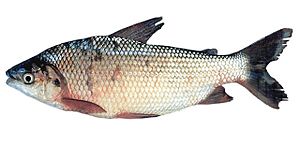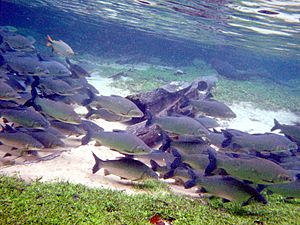Streaked prochilod facts for kids
Quick facts for kids Prochilodus lineatus |
|
|---|---|
 |
|
 |
|
| Scientific classification | |
| Synonyms | |
|
Prochilodus platensis |
The streaked prochilod, known scientifically as Prochilodus lineatus, is a type of ray-finned fish. It belongs to the Prochilodontidae family. This fish lives in the rivers of South America. You can find it in the Paraná, Paraguay, and Paraíba do Sul river basins. These fish are famous for their long journeys. They travel far to find places to lay their eggs. They are also very important for local fisheries, meaning people catch them for food and trade.
Contents
What Is the Streaked Prochilod Called?
This fish has many different names depending on where you are. In Spanish-speaking countries, it is often called sábalo. In Brazil, people call it curimbatá, curimba, corimbatá, or grumatã. Sometimes, to tell it apart from other fish also called sábalo, people might call it sábalo jetón (meaning "big-mouth") or chupabarro ("mud-sucker"). These names describe its unique mouth.
How Does the Streaked Prochilod Look?

The streaked prochilod can grow quite large. It can reach up to 80 centimeters (about 31 inches) long. It can also weigh up to 9 kilograms (about 20 pounds). Most of the time, they are around 45 centimeters (about 18 inches) long.
Their body shape is tall and flat from side to side. They are usually greenish-gray on top. Their belly is a lighter color. Their fins are a yellowish-green. One of their most special features is their mouth. It is round and sticks out from their head. This mouth has two rows of tiny teeth.
How Does the Streaked Prochilod Behave?
This fish likes to live in deep parts of rivers. It has a very interesting way of eating. It is an illiophagous fish. This means it sucks up and eats organic mud from the river bottom. Its special mouth is perfect for this job. Because of this, it is hard to catch them with regular bait.
Streaked prochilods are also known for their long journeys. They travel in huge groups, called schools. They look for warm waters, especially in the spring. This is when they lay their eggs and reproduce.
The Streaked Prochilod in the Paraná River
The streaked prochilod is a very important fish in the Paraná River. It is considered a "key species." This means it forms the base of the food chain. Many other larger fish, like the surubí catfish and the golden dorado, eat the streaked prochilod. This makes it vital for the river's ecosystem.
For many years, people have caught a lot of these fish. They are caught for local use and for export to other countries. Sometimes, too many fish are caught. This can make their numbers go down. Experts say that catching more than 20,000 tonnes of sábalo per year is too much. It is not sustainable, meaning the fish population cannot recover fast enough.
When fish populations get smaller, fishermen might start catching younger, smaller fish. These fish have not had a chance to reproduce yet. This can make the problem even worse.
There have been efforts to protect these fish. Rules about the size of nets and the length of fish that can be caught have been made. Environmental groups have also spoken out. They want to make sure the fish are protected for the future.
Images for kids
See also
 In Spanish: Prochilodus lineatus para niños
In Spanish: Prochilodus lineatus para niños



